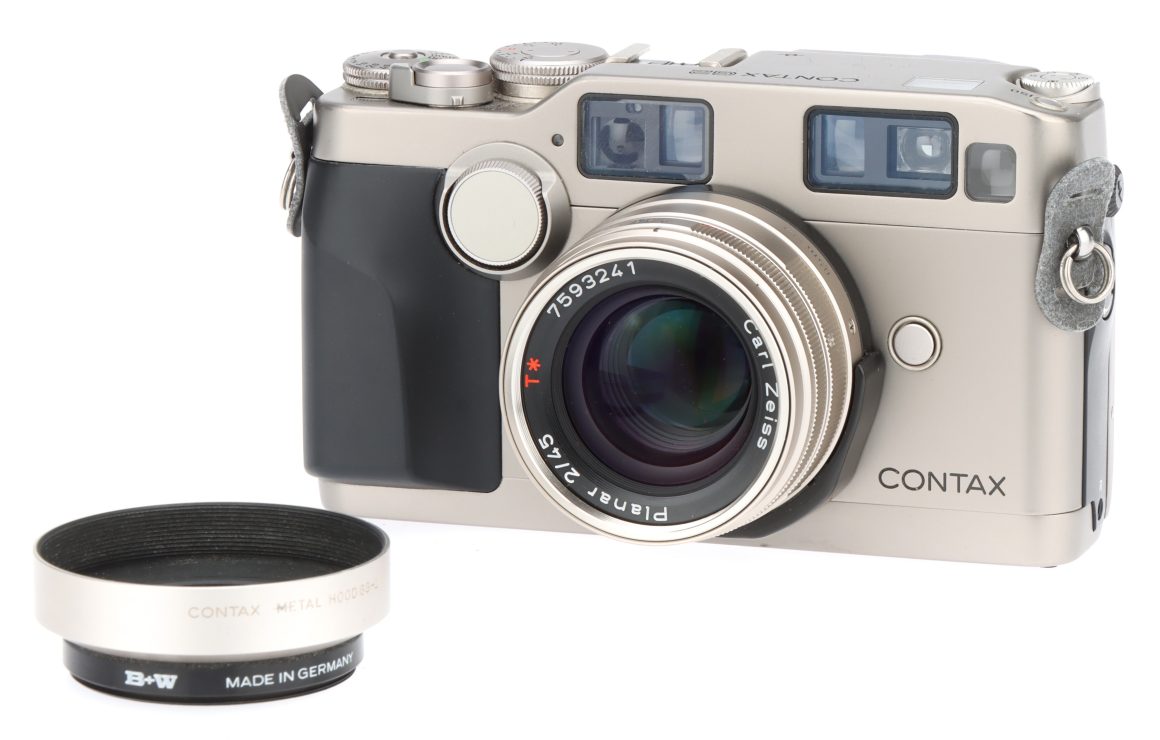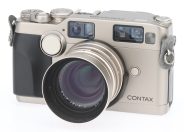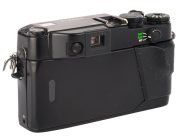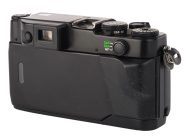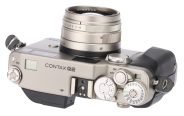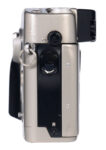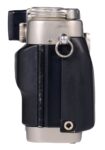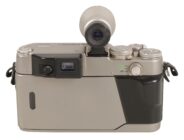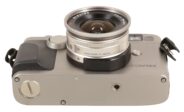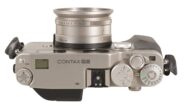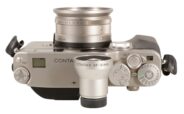Contax G2
35mm AF film rangefinder camera
Specification
| Production details: | |
| Announced: | September 1996 |
| System: | ● Contax G (1994) |
| Format: | |
| Maximum format: | 35mm full frame |
| Film type: | 135 cartridge-loaded film |
| Mount and Flange focal distance: | Contax G [28.95mm] |
| Shutter: | |
| Type: | Focal-plane |
| Model: | Electronically controlled |
| Speeds: | 16 - 1/6000 + B |
| Exposure: | |
| Exposure metering: | Through-the-lens (TTL), open-aperture |
| Exposure modes: | Aperture-priority Auto |
| Manual | |
| Rangefinder and Viewfinder: | |
| Rangefinder: | Built-in, combined with viewfinder |
| Viewfinder: | Built-in, combined with rangefinder |
| Finder magnification: | 0.57x |
| Bright-line frames: | - |
| Parallax compensation: | Yes |
| Physical characteristics: | |
| Weight: | 560g |
| Dimensions: | 139x80x45mm |
Manufacturer description #1
CONTAX Intoduces the G2
New, Feature-Packed Rangefinder is an Addition to the Contax G Series of Professional AF Cameras
September 3, 1996
SOMERSET, NJ -- Contax is adding to its much heralded G Series of professional cameras with the new G2, a feature-packed rangefinder that will become the flagship of the line. In addition to the many features the G2 shares with its sister camera, the legendary G1, this new camera offers a four frame per second integrated motor drive, top shutter speeds of up to 1/6000 second, X sync at 1/200 second and an extended baseline autofocus system.
"Our Contax G1, which has been so successful since its launch in 1994, has inspired us to now offer photographers even more features with the new G2," said Lee R. Middleton, Marketing Director, Contax North America.
The Contax G2 is capable of working with any of six interchangeable Carl Zeiss T* lenses. Two are new, the Biogon 21mm f2.8 and the Planar 35mm f2.0. The other four lenses in the G series include the Hologon 16mm f8, Biogon 28mm f2.8, Planar 45mm f2.0 and Sonnar 90mm f2.8.
The titanium clad G2 features a large, True Image Zoom Viewfinder that displays shutter speed, manual metering pointers, flash ready, exposure compensation and AF focusing distance. The viewfinder automatically adjusts to the mounted lens and will correct for parallax.
Additional features of the G2 include a sophisticated auto focus system that offers external passive auto focus plus an active infrared AF focusing system, a TTL center-weighted average light metering system, flash synchronization and AF lock.
A selection of custom functions are available to those using the G2, which include AE lock operation, Automatic Bracketing order, film leader status, focus operation in manual setting, multiple exposure ISO setting, focusing distance, battery check and frame counter.
There is an optional data back available for the G2, the Contax GD-2, which makes it possible to record technical information about each photo directly onto negatives in several different ways. A new G Series flash unit, the TLA200, is also being introduced with the G2.
The G2 body, which comes with a three-year limited warranty, will be available this Fall for a list price of $2,250.
Manufacturer description #2
The Revolution Continues
CONTAX G2
Contax continues the direction set in 1994 by adding another revolutionary camera to its professional AF rangefinder line. The G2 becomes the flagship camera in a professional line that continues to grow. The G2 raises the standard for rangefinder cameras with a four frame per second integrated motor drive, top shutter speeds of up to 1/6000 second, X sync at 1/200 second and adds an extended baseline autofocus system.
The Carl Zeiss T* lenses line is now enhanced with the addition of the Carl Zeiss T* Biogon 21mm f2.8 and the Planar 35mm f2.0. These lenses are wide angle formulas achieving the lowest distortion and highest optical quality. The new GD-2 Multi-Function Data Back has a special feature that allows printing all technical details used throughout the roll on the first or first and second frames of the roll. Optionally, this same data may be printed between frames or turned off. Contax has also added the Contax TLA200 electronic TTL flash to the G series line. The TLA200 adds flash power and a zoom head for more versatile electronic flash photography.
The Contax G2 Features:
- Elegant, yet extremely durable titanium body
- Six optional interchangeable Carl Zeiss T* lenses
- Shutter speeds: AV: 16 sec. to 1/6000 second, Manual: 4 seconds to 1/4000 sec.
- Direct X synchro contact at 1/200 second
- Large, true image zoom viewfinder
- Four frames per second motor drive built-in
- External passive AF plus active infrared autofocus system
- New optional GD-2 Multi-Function Databack
- Three Year Limited USA Warranty
New Lenses - Accessories
NEW
The Biogon is a legendary lens formula which is used in the 28mm f2.8. We now introduce a second Biogon, the Carl Zeiss T* Biogon 21mm f2.8. The name Biogon assures users that performance will be truly awesome!
NEW
The new Carl Zeiss T* Planar 35mm f2.0 wide angle lens for available light photography. As with all Carl Zeiss T* lenses, distortion is very well controlled while contrast and color saturation remain exceedingly high.
Hologon T* 16mm f8 extreme wide angle lens. The Hologon is famous for its ability to record an extremely wide angle of view (106 degrees) with no distortion.
Carl Zeiss T* Biogon 28mm f2.8. An awesome high quality true wide-angle performer with very low distortion and outstanding contrast and saturation.
Carl Zeiss T* Planar 45mm f2.0. A fast normal lens for the G series system, the 45mm Planar offers extremely high resolution along with excellent contrast.
Carl Zeiss T* Sonnar 90mm f2.8. The Sonnar is a very sharp, high contrast tele lens. The finest medium telephoto lens ever produced for 35mm photography.
NEW
Contax System Flash for the Contax G2 - The Contax TLA200.
NEW
Contax Multi-Function Data Back GD-2
Manufacturer description #3
High-speed shutter attains a stunning 1/6000 second
Of primary concern to the designers was overall response. For ths purpose, an electronically controlled, vertically running, focal plane shutter was developed to achieve this high shutter speed, the functional equivalent of a CONTAX SLR. This shutter offers improved accuracy along with an enhanced capability for sports and action photography. The X sync shutter speed has been increased to a very useful 1/200 second for more versatile and efficient fill flash photography.
High performance four motor design
Four motors, each independently activated, are incorporated into the compact camera body. DC coreless motors for winding, rewinding, and shutter movement, a DC motor for lens drive, plus a pulse motor for parallax compensation offer fast, efficient movement of the jewel-like internal components of the G2. The CPU allows high speed frame rates of up to approximately four frames per second in the Continuous High (CH) mode.
Shutter response is greatly enhanced
While the G2 has succeeded in enhancing AF response time, shutter response time has been reduced even in the manual (MF) mode. This modification is precisely what the professional photographer has wanted. The G2 offers a focusing system that performs with little or no delay. The focus lock is set at the desired position in advance. When the shutter is tripped in manual, the lens is driven at high speed to the pre-determined focus position. Response is much quicker.
Overall dampening of operational noise
A requirement in many kinds of photography calls for the photographer to be an unobtrusive observer. In the G2 special attention has been paid to the suppression of noise. All materials must conform to strict standards for noise dampening. CONTAX has developed a new type of winding mechanism for the G2 that utilizes a winder belt for quiet operation. When you operate the CONTAX G2, you'll feel high quality pervading all aspects of the design, a silky and silent experience to be sure.
Precise center-weighted average metering
Light metering is achieved with a center-weighted average metering system (through-the-lens, with the aperture stopped down). The silicon photo diode (SPD, light metering sensor) offers precise metering over a wide EV1 to EV19 range. When the Hologon T* 16mm f8 lens is used, metering automatically switches to an external metering system.
More advanced, accurate autofousing is achieved by combining passive AF with an extended baselength, and an externally metering active AF system
Improved shutter response inevitably requires an upgrade in the autofocusing mechanism. To ensure precision focusing while speeding up the response time, the engineering team developed a two-chip CPU configuration that combines active AF with traditional passive AF technology.
The G2 initially rough focuses the subject using the ultra high speed active AF system. Then, the extremely accurate passive AF system takes over and hones the point of focus to perfection.
Two simple means of precise exposure control; aperture priority or manual
Aperture Priority or Manual exposure control are easily selected on the shutter speed dial. AE Lock is set simply by turning the main power switch to the AE-L position. A quick check of the selected shutter speed is available by pressing the shutter release button halfway.
Focus lock button ensures more convenient operation
While retaining the G1 focus lock function (by depressing the shutter release half-way), the G2 offers a dedicated focus lock button on the rear of the body. By using this button, the focus is locked at the desired position, even if the subject moves out of the focus frame in the CAF (Continuous Autofocus) mode. Further, when this feature is used in the MF (Manual Focus) mode, the shutter speed indication within the viewfinder LCD changes to a display of the focusing distance.
Manual focus dial enhances manual focus
The CONTAX G2 positions the manual focusing dial on the front of the body to enable the photographer to accomplish smoother, more subtle manual focusing. With the Hologon T* 16mm f8 lens, manual focusing is done with the lens focusing ring, instead of the focusing wheel on the body.
Real image zoom viewfinder for precise framing
The viewfinder is accurate and easy to view. It is a real image zoom type with a magnification of 0.57X and a field of view 90% (at infinity with Planar T* 45mm f2). Parallax distortion caused by different focal lengths and focusing distances are automatically, almost steplessly corrected by means of a newly designed and dedicated pulse motor. This system offers a more accurate parallax adjustment that slides the viewfinder diagonally to provide an enhanced field of view.
Easier-to-see, large LCD viewfinder
Photographic data such as shutter speed, exposure warning, flash ready, exposure compensation and AF distance are indicated on a large LCD panel in the viewfinder. This format allows the photographer to concentrate on the subject while only a glance is necessary to inform the user about vital parameters.
High-quality flash photography under a wide range of photographic conditions
The compact, high perfromance Auto Flash TLA200 unit was developed with 'pocket-ability' in mind. It will cover the focal lengths from 28mm to 90mm using a built-in zoom head. The TLA200 quickly couples to the G2 and provides TTL flash metering, daylight fill flash or slow shutter sync (by using the AE lock). Recycling is also quick at approx. 3.5 second recharge time.
Further, the TLA200 is fully compatible with the CONTAX TLA Flash system. This system provides sophisticated flash techniques, such as second curtain sync with the TLA280, TLA360 and TLA480.
Full range of drive modes and A.B.C. function
With the CONTAX G2, a full range of drive modes is available; S (single), CL (continuous low, approx. 2 frames per second), CH (continuous high, approx. 4 frames per second), self-timer (10 second delay), and multiple exposure. Additionally, the built-in Automatic Bracketing Control (A.B.C.) function (automatic exposure compensation on three consecutive frames) allows the photographer to do an exposure sequence consisting of one frame standard, one over and one under exposed. This can be accomplished in either a 0.5 or 1.0 step increment.
Beautifully finished full titanium body covering for high durability
Because CONTAX owners expect that only the finest materials will be used, lustrous titanium is employed as a body covering over the entire G2. This is an ideal material for a camera body, lightweight, rigid, shock and corrosion resistant. Overall, a perfect container for the inner workings of the G2. Further, the grip section has been rubberized to enhance the feel and comfort of the G2 in the hand.
Rigid copper/silumin aluminum alloy diecast chassis, durable even under harsh conditions
The chassis of the G2 securely supports the lens mount as well as the guide rails at the rear of the camera. Even repeated lens changing has no effect on the chassis/lens mount interface. The copper/silumin chassis is high temperature/high pressure steam annealed to eliminate distortion and add tempering for extra hardness.
Extended dioptric adjustment
The CONTAX G2 viewfinder eyepiece may be adjusted within the range +0.3D to -2.0D by turning the diopter adjuster. To extend this range, three optional diopter lenses GFL (-4), GFL (-2) and GFL (+2) - have been added to the system, providing a range from +3D to -5D.
Custom functions allow customization of many camera functions
The CONTAX G2 is designed to allow the user to change the basic settings of the following functions:
- AE Lock method
- A.B.C. bracketing order: standard-over-under (default setting); over-standard-under (optional setting)
- Film leader upon rewinding: Film fully rewound into the cassette (default setting); leader left out after rewinding (optional setting)
- The manner of adjusting the focusing distance in manual focus
- Multiple exposure system
Special limited editions (1)
- Contax G2 "CONTAX 70 Years" (300 units) - March 2002
